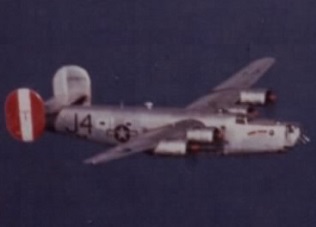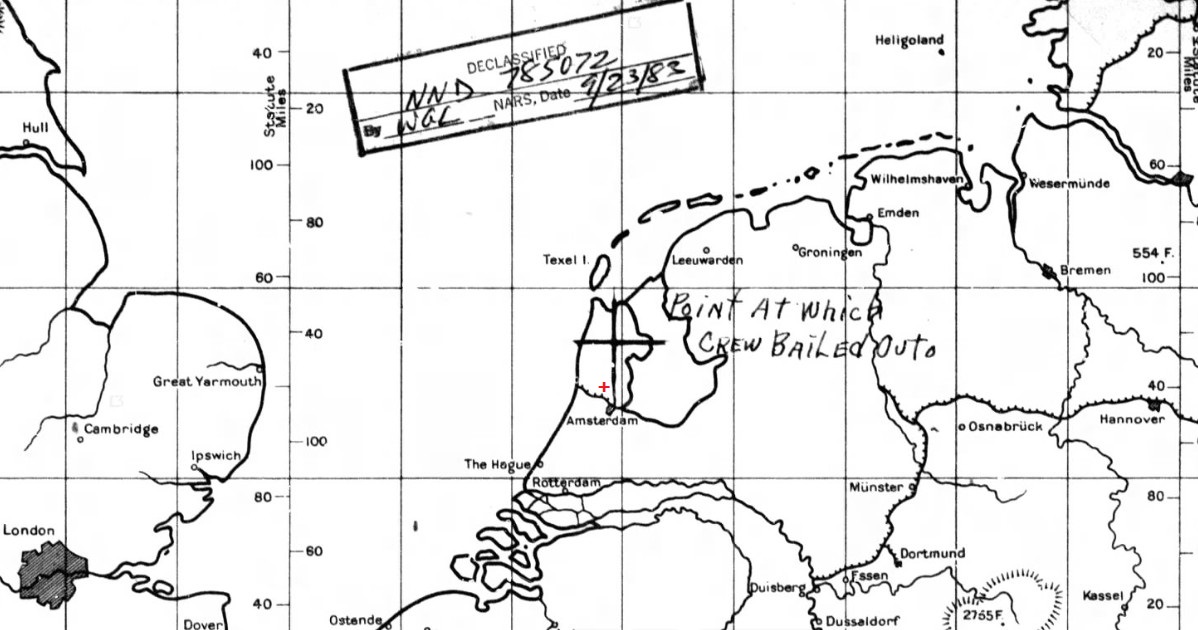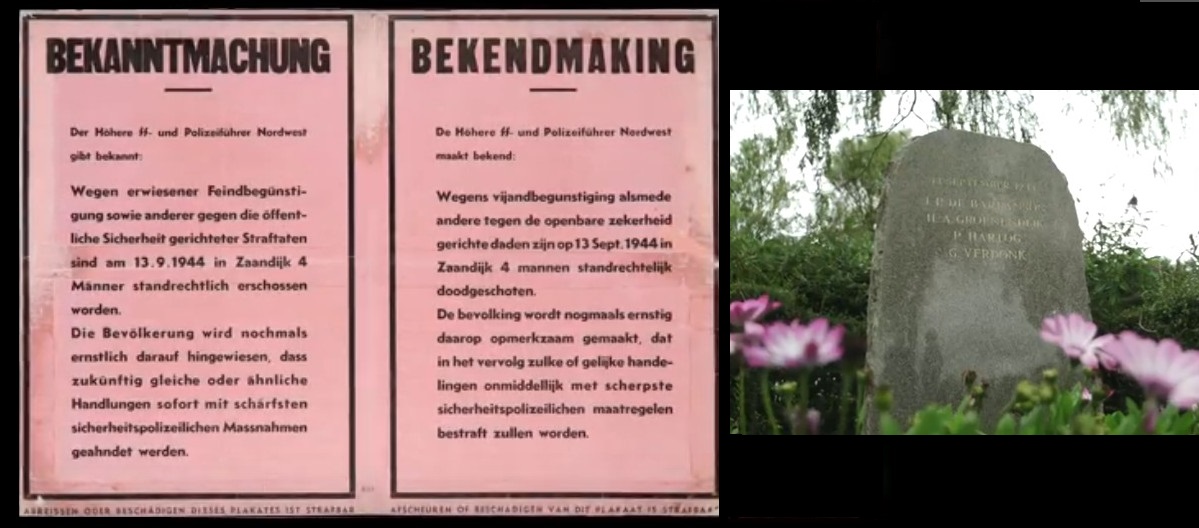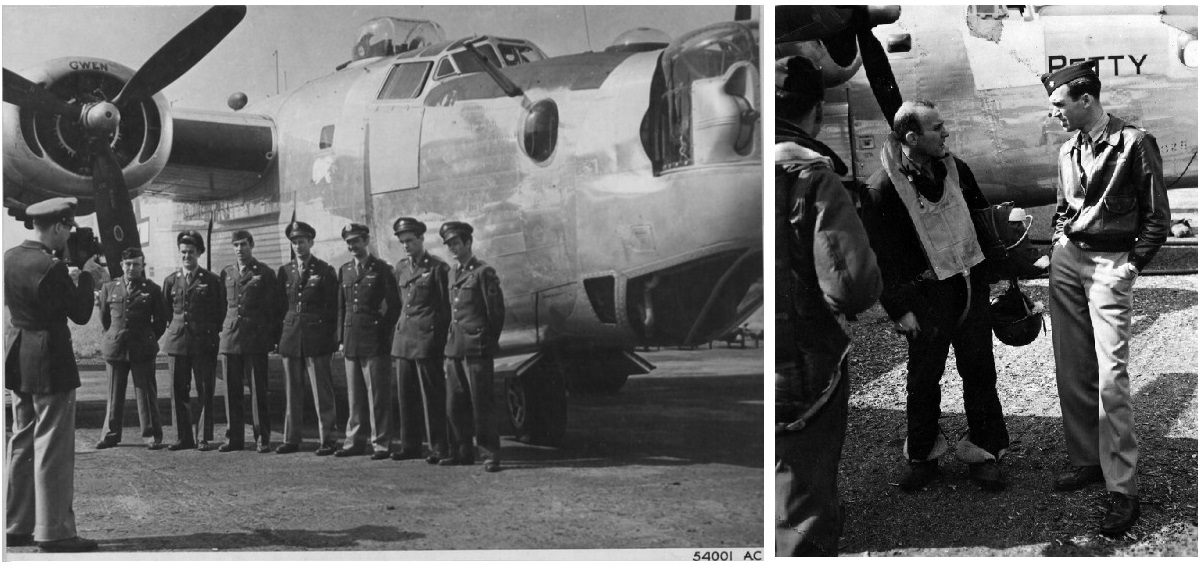| Date: 1944 Sep 11/11 | A/C Type: B-24 J Liberator | SN: 44-40092 | Code: | A/C Nickname: Betty Jane |  |
|||||
| File: 305 | Airforce: USAAF | Sqn/Unit: 389 BG - 565 BS | Mission/Raid: Misburg near Hannover | |||||||
| 1 | Pilot | Captain Merrill S. Olson evd, later POW | 9 | RWG | S/Sgt. Michael J. Missano POW | |||||
| 2 | Co-pilot | Major John R. Dowswell RTD | 10 | TG | Sgt. William F. Zimmerlin POW | |||||
| 3 | Nav. | Captain Gerald D. Crary Jr POW direct | 11 | |||||||
| 4 | Nose gunner | 2Lt. Richard M. Jensen POW | 12 | |||||||
| 5 | B | 1Lt. James Finbar Cotter POW | 13 | |||||||
| 6 | RO | T/Sgt. Christopher J. Smith evd, sheltered | 14 | |||||||
| 7 | E | T/Sgt. Daniel R. Redd evd, sheltered | 15 | |||||||
| 8 | LWG | S/Sgt. Charles T. Adkisson POW | 16 | |||||||
Flak over Misburg had caused problems to engine no.4. On the return, the aircraft dropped slowly out of formation and lost altitude. North of Amsterdam, north of Oostzaan nine crew parachuted out, but co-pilot flew the bomber back to England. The crew was hidden by locals in Zaandijk (Zaanse Schans) and Wormerveer, but the Germans took reprisals and received five airmen back on 15 September 1944. |
||||||||||
Statement co-pilot Major John R. Dowswell in MACR: "North of Amsterdam pilot Olson decided that not enough altitude could be maintained to clear the North Sea to reach England and gave order to bail out. I requested permission to try and fly aircraft back to base, which was granted by Olson. After losing more altitude, engine no. 4 was feathered. Aircraft responded to controls and I flew back to England".
Dowswell reported jump location of crew was 20 miles north of Amsterdam (see his cross on map below), but in fact it was only 3 miles. The actual position was at the red mark. He probably could not see Amsterdam because he was in the co-pilot seat and looked into northwest Holland. Over Lake IJsselmeer (Old Zuyder Sea) the crew had thrown everything overboard to loose weight, but the bomber kept losing altitude. Aircraft entered the Lake-coastline at Marken Island and left Holland low flying in area of IJmuiden. Dowswell was extremely lucky that the Flak at the Dutch North Sea coastline did not get him.

Nine bailed out, four executed, six arrests.
The nine men that bailed out came down in isolated pastures, full with canals and ponds. Farmers helped every airman to escape the scene before the Germans would arrive. Only navigator Captain Gerald Crary broke his ankle and could not move (POW). The other eight were guided into farms and then to safehouses in Zaandijk and Wormerveer. Despite the fact that it took only 10 minutes before the German cars were present, they could not find any airmen besides Captain Crary. They were furious and rushed into and searched every house in the area for two days. They found a parachute in the store of pharmacist Gerrit Verdonk in Zaandijk, he was arrested. Next day 13 September 1944, Verdonk and three suspected-to-be resistance fighters from Amsterdam jail were shot dead on the side of the Leegwater-road outside Zaandijk. The names of the resistance men were Johan de Barbanson, Herman Groenendijk and Pieter Hartog. Pamflets claimed they were executed for pilothelp, population was warned.
It was announced by loudspeaker that another 18 men would be shot when the hidden airmen would not be handed over to the Germans. The situation was explained to the Americans and next day, 15 September, five crew members turned themselves in. They were: 2Lt. Richard Jensen, 2Lt. James Cotter and sergeants Adkisson, Missano and Zimmerlin. The Germans had captured now in total six men. They did or did not know nine men had parachuted down, but were pleased with six and stopped the search.

Three evaders
It seems that the youngest had to turn themselves in. Three crew members stayed in hiding: pilot Captain Merril S. Olson, engineer T/Sgt. Daniel R. Redd and radio operator T/Sgt. Christopher J. Smith from New York City, who was on his 29th mission.
Sergeants Redd and Smith had about the same evader route, although they were never together in the same safehouse. Both stayed at first in the home of resistance leader Dick Bus in Wormerveer. Smith then was for four months in Krommenie at Dick 'Poutsme' (?). Then he was in West-Graftdijk, one week in Amsterdam, five days in Utrecht and six weeks in Culemborg. Sgt. Redd was in Wormerveer for months until 12 February 1945, then also one week in Amsterdam, Utrecht, Culemborg, Woerden, Buren (Betuwe) and finally a farm in Neerijen (opposite Zaltbommel). Both were 212 days underground and 'sheltered in the Netherlands until liberated'. This was on 11 April 1945, but because their hiding area was still in German hands until 5 May 1945, it seems they crossed the river Waal (front line) probably near Zaltbommel and reported to the Canadian army on the southern river bank.
Pilot Merrill Samuel Olson had severe blood-loss from his left leg, caused by Flak-shrapnel over Misburg. It got infected and he had to be housed in hiding with a doctor in Amsterdam. There it became clear that Captain Olson was not the standard airman the resistance had in its care. During his stay with the doctor and despite the wounds, Olson went onto the street at night (streets were forbidden after curfew) and stole two bikes of German soldiers. He believed his journey to the South took too long and said to the doctor: "I will use these for my trip to the border". Also on other addresses Olson was causing trouble. Local publications say that Olson was a "huge pain in the neck" for the resistance men who risked their life for him. He was armed with a revolver, chain smoking also in secret hiding spaces. Once he entered the street, armed, smoking cigarettes that nobody had, overdressed in fancy suit that made him stand out like a sore thumb, putting his hiders at huge risk. Via Rotterdam and Zwijndrecht, Olson came in s'Gravendeel. Here he met in a safehouse evader Canadian Sgt. Kenneth Dugdale, bailed out 12 December 1944 at Dordrecht.
A first attempt to cross the river from Piershil, via Tiengemeten Island to Willemstad on the Allied side failed because of fog. Olson learned from old boat captains that he had more chance of a successful river crossing in village Strijen. Olson took Dugdale with him on a bicycle to Strijen (14 miles though German front zone). A German guard stopped them, but they barely escaped, cycling away as hard as he could. In Strijen nobody expected them, a butcher took them in. More evaders (Dutchmen) entered Strijen en the group evaders became bigger and bigger. When the most experienced guide is sick, the group asked other men to guide in the night of the 24th of December. Despite the fact the best guide is sick and it is a full moon night, the group (one source says Olson) decided to give it a try, because expected was that because of Christmas, the Germans are less on their guard. In the dark at the river dyke at 04:00 hours, the group runs into a large group of German soldiers who open fire immediately. One man is shot dead, Olson, Dugdale and the others are arrested. Four men were executed on 7 January 1945. Olson and Dugdale became POW.
Below: Crew Betty Jane, last three men right: Olson, Smith & Redd. Right: after he landed the plane alone, co-pilot Major Dowswell talks to Jimmy Stewart.

Sources:
- MACR
- E & E report Sgt. Smith and Sgt. Redd
- Website 'Tobias' radio traffic 1944: http://www.weggum.com/November_wk4.html
- Website 'Tobias' on Capt. Olson http://www.weggum.com/inhoudsopgave_Tobias.html
- Book 'De luchtoorlog boven de Zaanstreek', by Mr. Bram Kemp, 2009.
- http://www.b24bestweb.com/bettyjane-v2-2.htm
- http://www.b24bestweb.com/bettyjane-v2-1.htm
© ZZairwar (Zuyder Zee Air War)
.